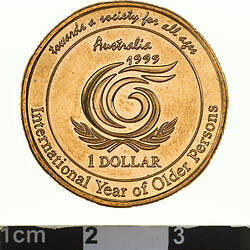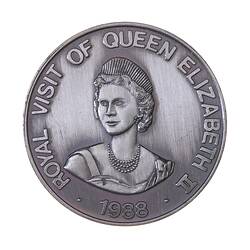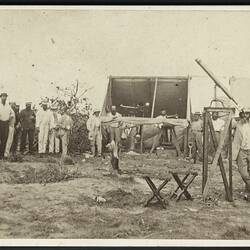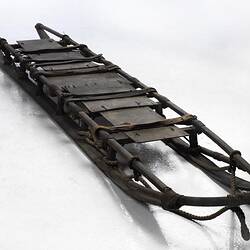Summary
Australia
2007 (AD)
One Dollar Uncirculated coin .
International Polar Year 2007-2008. Polar Series.
Issued by Royal Australian Mint in collector's display card.
Designer: W. Pietranik.
The International Polar Year 2007-2008 is a program of outreach and education into polar science. It is sponsored by the International Council for Science (ICSU) and the World Meteorological Organization (WMO), to examine the Earth's Polar regions and their effect on the global environment. The Royal Society of Victoria is also involved with IPY.
Physical Description
An aluminium /bronze coin sealed into a display card. Display card features Frank Hurley photograph of ship Aurora with penguins in foreground. Map of Antarctica with Australian bases Mawson Casey and Davis indicated. On reverse, information about International Polar Year, and photo credits.
Obverse Description
Head of Elizabeth II. Around, ELIZABETH II / AUSTRALIA 2007. Artist's initials IRB.
Reverse Description
Image of ship Aurora (based on Frank Hurley photograph) with penguins in foreground. Map of Antarctica in background, with Australian bases Mawson Casey and Davis indicated. Across centre, 90 degrees East and West is marked. Above ship, 1 DOLLAR. Around, AUSTRALIAN ANTARCTIC TERRITORY / INTERNATIONAL POLAR YEAR 2007-2008.
Significance
Dr John Long was the Master of Ceremonies at the launch of Royal Society of Victoria's programme for IPY, on 1st March 2007 . The International Polar Year 2007-2008 is a program of outreach and education into polar science. It is sponsored by the International Council for Science (ICSU) and the World Meteorological Organization (WMO), to examine the Earth's Polar regions and their effect on the global environment. Museum Victoria undertakes research in Antarctica, and is conducting public programs as part of the IPY.
This is the first of three coins in the Polar Series.
International Polar Year 2007-2008 is the fourth international Polar year following the first in 1882-83 and again in 1932-33 and 1957-1958. They are opportunities to focus scientific research on the Arctic and Antarctic regions.
More Information
-
Collection Names
-
Collecting Areas
Numismatics & Philately, Science & Measurement, Sustainable Futures
-
Acquisition Information
Purchase from Dr John Long - Museum Victoria, 02 Mar 2007
-
Date Issued
2007 AD
-
Place Depicted
-
Issued By
-
Mint
Royal Australian Mint, Canberra, Denison Street, Deakin, Greater Canberra, Australian Capital Territory, Australia, 2007
-
Artist
Wojciech Pietranik - Royal Australian Mint, Denison Street, Deakin, Greater Canberra, Australian Capital Territory, Australia, 2007
-
Designer
-
Organisation Named
Royal Society of Victoria (RSV), 9 Victoria Street, Melbourne, Greater Melbourne, Victoria, Australia, 2007
-
Person Named
-
Inscriptions
Obverse: Head of Elizabeth II. Around, ELIZABETH II / AUSTRALIA 2007. Artist's initials IRB. Reverse: Image of ship Aurora (based on Frank Hurley photograph) with penguins in foreground. Map of Antarctica in background, with Australian bases Mawson Casey and Davis indicated. Across centre, 90 degrees East and West is marked. Above ship, 1 DOLLAR. Around, AUSTRALIAN ANTARCTIC TERRITORY / INTERNATIONAL POLAR YEAR 2007-2008.
-
Denomination
-
Series
-
Material
Aluminium Bronze
-
Classification
-
Category
-
Discipline
-
Type of item
-
Part Dimensions
25 mm (Outside Diameter), 9 g (Weight)
Dimension of coin only.
-
Primary support
150 mm (Length), 70 mm (Width)
Dimension of leaflet with coin attached.
-
Shape
Rectangle
-
References
Mint Issue, Feb 2007 Number 69.
-
Keywords
Antarctic Exploration, Exploration, International Polar Year, 2007-2009, Natural Environment






